University System Analysis and Design Report: My Health Record
VerifiedAdded on 2021/04/17
|8
|1553
|29
Report
AI Summary
This report provides a comprehensive analysis and design of the 'My Health Record' system, initiated by the Commonwealth Government of Australia. It addresses the inefficiencies and disadvantages of manual record-keeping and proposes an electronic solution to improve patient care and reduce healthcare costs. The report outlines the problems associated with manual systems, such as data inconsistency, storage issues, and limited access for healthcare providers. It then details the capabilities of the 'My Health Record' system, including secure online summaries, controlled access for patients and physicians, and improved interactions between healthcare providers and patients. Furthermore, it highlights the benefits of the system, such as enhanced security, 24/7 patient-physician connectivity, and convenience for patients. The conclusion recommends implementing the system to reform healthcare services and drive efficiency. The report references several studies supporting the advantages of electronic health records and the importance of patient data security and access control.
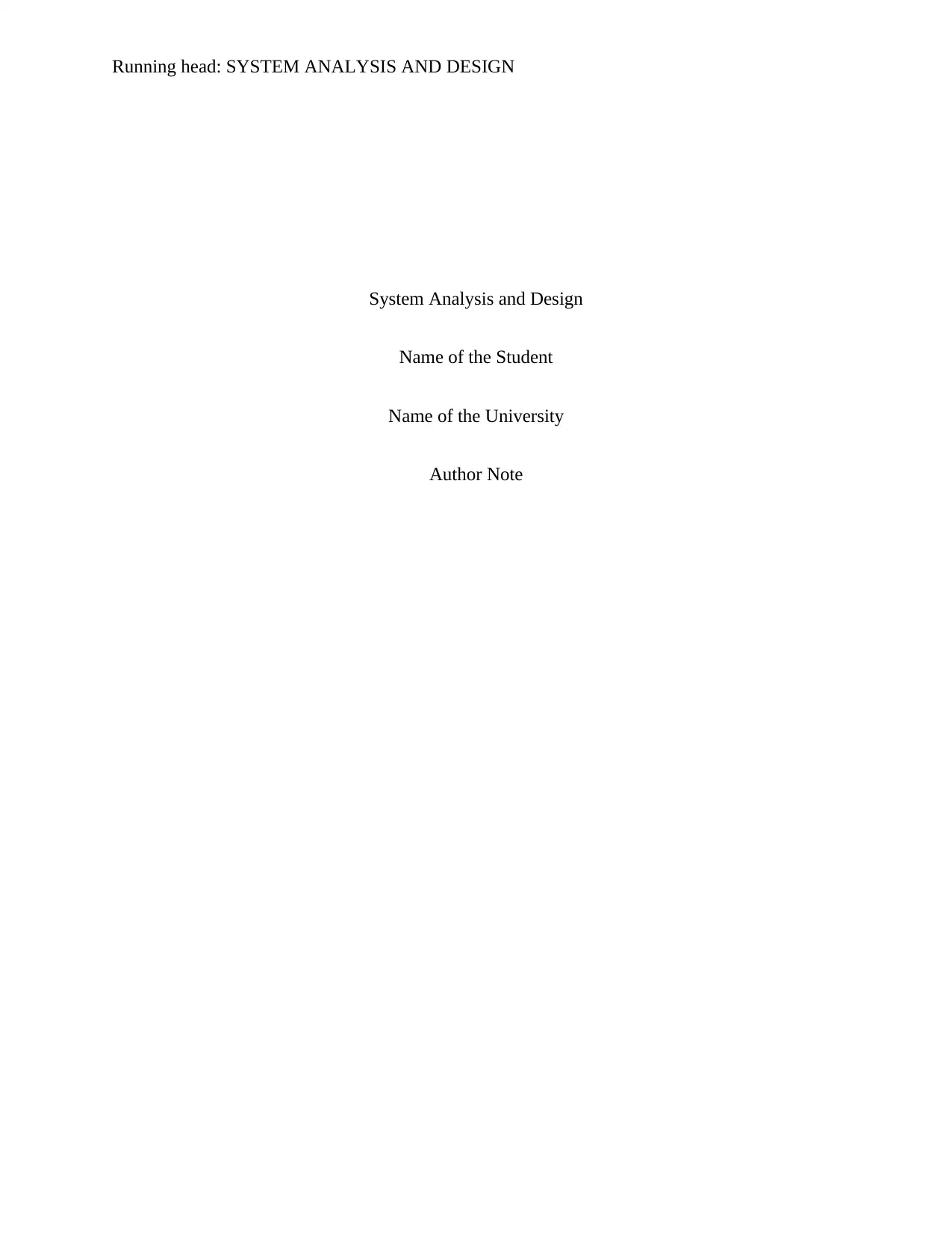
Running head: SYSTEM ANALYSIS AND DESIGN
System Analysis and Design
Name of the Student
Name of the University
Author Note
System Analysis and Design
Name of the Student
Name of the University
Author Note
Paraphrase This Document
Need a fresh take? Get an instant paraphrase of this document with our AI Paraphraser
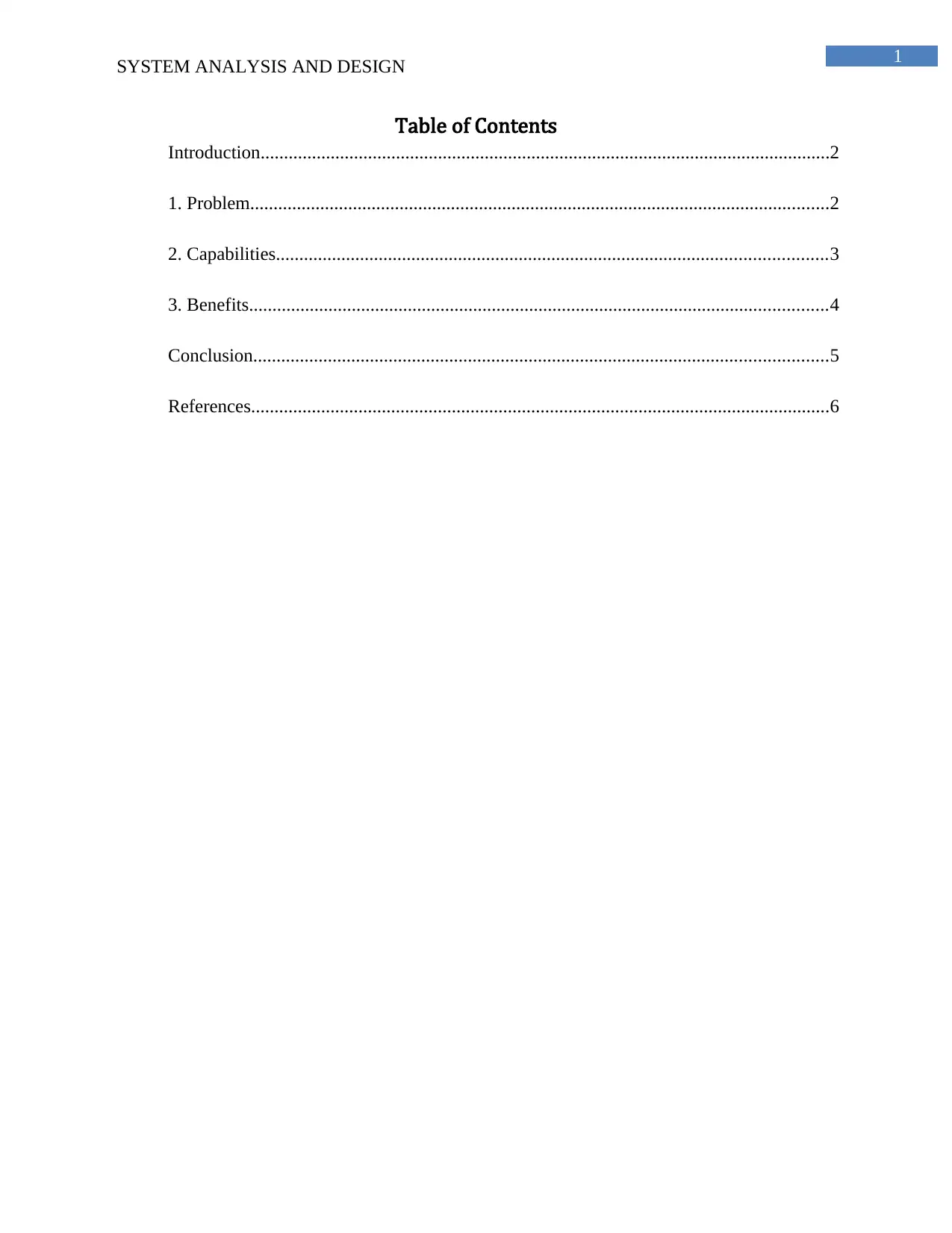
1
SYSTEM ANALYSIS AND DESIGN
Table of Contents
Introduction..........................................................................................................................2
1. Problem............................................................................................................................2
2. Capabilities......................................................................................................................3
3. Benefits............................................................................................................................4
Conclusion...........................................................................................................................5
References............................................................................................................................6
SYSTEM ANALYSIS AND DESIGN
Table of Contents
Introduction..........................................................................................................................2
1. Problem............................................................................................................................2
2. Capabilities......................................................................................................................3
3. Benefits............................................................................................................................4
Conclusion...........................................................................................................................5
References............................................................................................................................6
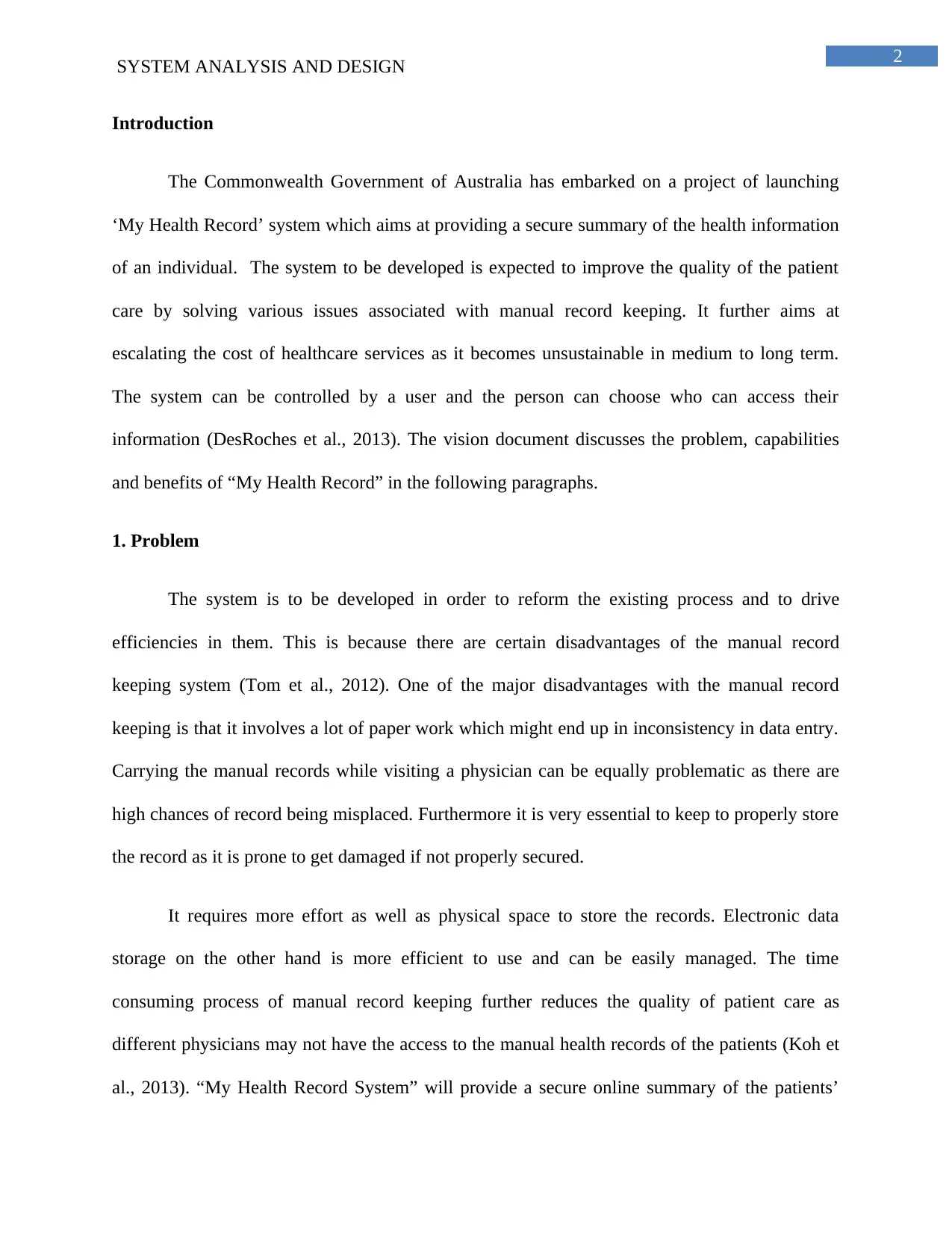
2
SYSTEM ANALYSIS AND DESIGN
Introduction
The Commonwealth Government of Australia has embarked on a project of launching
‘My Health Record’ system which aims at providing a secure summary of the health information
of an individual. The system to be developed is expected to improve the quality of the patient
care by solving various issues associated with manual record keeping. It further aims at
escalating the cost of healthcare services as it becomes unsustainable in medium to long term.
The system can be controlled by a user and the person can choose who can access their
information (DesRoches et al., 2013). The vision document discusses the problem, capabilities
and benefits of “My Health Record” in the following paragraphs.
1. Problem
The system is to be developed in order to reform the existing process and to drive
efficiencies in them. This is because there are certain disadvantages of the manual record
keeping system (Tom et al., 2012). One of the major disadvantages with the manual record
keeping is that it involves a lot of paper work which might end up in inconsistency in data entry.
Carrying the manual records while visiting a physician can be equally problematic as there are
high chances of record being misplaced. Furthermore it is very essential to keep to properly store
the record as it is prone to get damaged if not properly secured.
It requires more effort as well as physical space to store the records. Electronic data
storage on the other hand is more efficient to use and can be easily managed. The time
consuming process of manual record keeping further reduces the quality of patient care as
different physicians may not have the access to the manual health records of the patients (Koh et
al., 2013). “My Health Record System” will provide a secure online summary of the patients’
SYSTEM ANALYSIS AND DESIGN
Introduction
The Commonwealth Government of Australia has embarked on a project of launching
‘My Health Record’ system which aims at providing a secure summary of the health information
of an individual. The system to be developed is expected to improve the quality of the patient
care by solving various issues associated with manual record keeping. It further aims at
escalating the cost of healthcare services as it becomes unsustainable in medium to long term.
The system can be controlled by a user and the person can choose who can access their
information (DesRoches et al., 2013). The vision document discusses the problem, capabilities
and benefits of “My Health Record” in the following paragraphs.
1. Problem
The system is to be developed in order to reform the existing process and to drive
efficiencies in them. This is because there are certain disadvantages of the manual record
keeping system (Tom et al., 2012). One of the major disadvantages with the manual record
keeping is that it involves a lot of paper work which might end up in inconsistency in data entry.
Carrying the manual records while visiting a physician can be equally problematic as there are
high chances of record being misplaced. Furthermore it is very essential to keep to properly store
the record as it is prone to get damaged if not properly secured.
It requires more effort as well as physical space to store the records. Electronic data
storage on the other hand is more efficient to use and can be easily managed. The time
consuming process of manual record keeping further reduces the quality of patient care as
different physicians may not have the access to the manual health records of the patients (Koh et
al., 2013). “My Health Record System” will provide a secure online summary of the patients’
⊘ This is a preview!⊘
Do you want full access?
Subscribe today to unlock all pages.

Trusted by 1+ million students worldwide
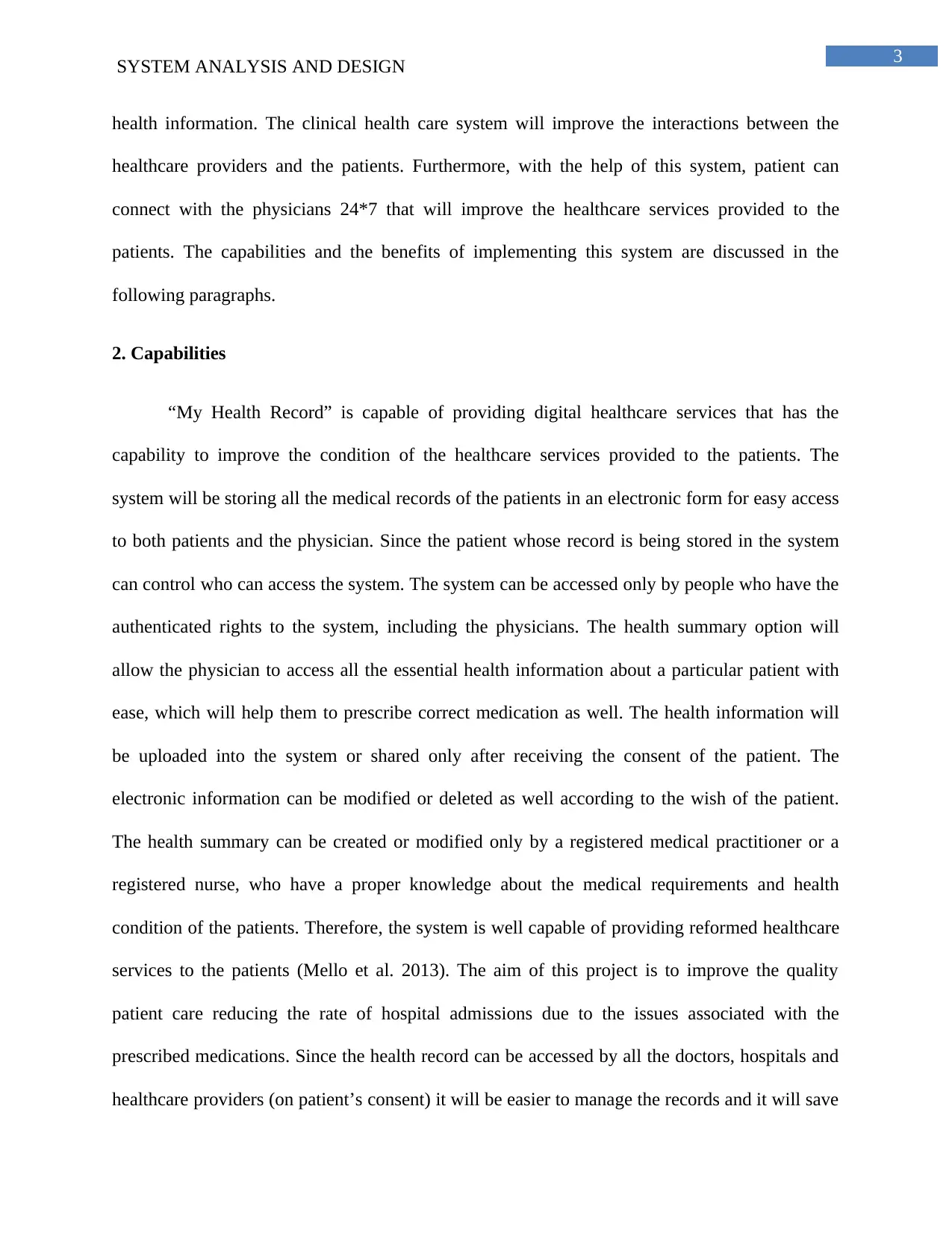
3
SYSTEM ANALYSIS AND DESIGN
health information. The clinical health care system will improve the interactions between the
healthcare providers and the patients. Furthermore, with the help of this system, patient can
connect with the physicians 24*7 that will improve the healthcare services provided to the
patients. The capabilities and the benefits of implementing this system are discussed in the
following paragraphs.
2. Capabilities
“My Health Record” is capable of providing digital healthcare services that has the
capability to improve the condition of the healthcare services provided to the patients. The
system will be storing all the medical records of the patients in an electronic form for easy access
to both patients and the physician. Since the patient whose record is being stored in the system
can control who can access the system. The system can be accessed only by people who have the
authenticated rights to the system, including the physicians. The health summary option will
allow the physician to access all the essential health information about a particular patient with
ease, which will help them to prescribe correct medication as well. The health information will
be uploaded into the system or shared only after receiving the consent of the patient. The
electronic information can be modified or deleted as well according to the wish of the patient.
The health summary can be created or modified only by a registered medical practitioner or a
registered nurse, who have a proper knowledge about the medical requirements and health
condition of the patients. Therefore, the system is well capable of providing reformed healthcare
services to the patients (Mello et al. 2013). The aim of this project is to improve the quality
patient care reducing the rate of hospital admissions due to the issues associated with the
prescribed medications. Since the health record can be accessed by all the doctors, hospitals and
healthcare providers (on patient’s consent) it will be easier to manage the records and it will save
SYSTEM ANALYSIS AND DESIGN
health information. The clinical health care system will improve the interactions between the
healthcare providers and the patients. Furthermore, with the help of this system, patient can
connect with the physicians 24*7 that will improve the healthcare services provided to the
patients. The capabilities and the benefits of implementing this system are discussed in the
following paragraphs.
2. Capabilities
“My Health Record” is capable of providing digital healthcare services that has the
capability to improve the condition of the healthcare services provided to the patients. The
system will be storing all the medical records of the patients in an electronic form for easy access
to both patients and the physician. Since the patient whose record is being stored in the system
can control who can access the system. The system can be accessed only by people who have the
authenticated rights to the system, including the physicians. The health summary option will
allow the physician to access all the essential health information about a particular patient with
ease, which will help them to prescribe correct medication as well. The health information will
be uploaded into the system or shared only after receiving the consent of the patient. The
electronic information can be modified or deleted as well according to the wish of the patient.
The health summary can be created or modified only by a registered medical practitioner or a
registered nurse, who have a proper knowledge about the medical requirements and health
condition of the patients. Therefore, the system is well capable of providing reformed healthcare
services to the patients (Mello et al. 2013). The aim of this project is to improve the quality
patient care reducing the rate of hospital admissions due to the issues associated with the
prescribed medications. Since the health record can be accessed by all the doctors, hospitals and
healthcare providers (on patient’s consent) it will be easier to manage the records and it will save
Paraphrase This Document
Need a fresh take? Get an instant paraphrase of this document with our AI Paraphraser
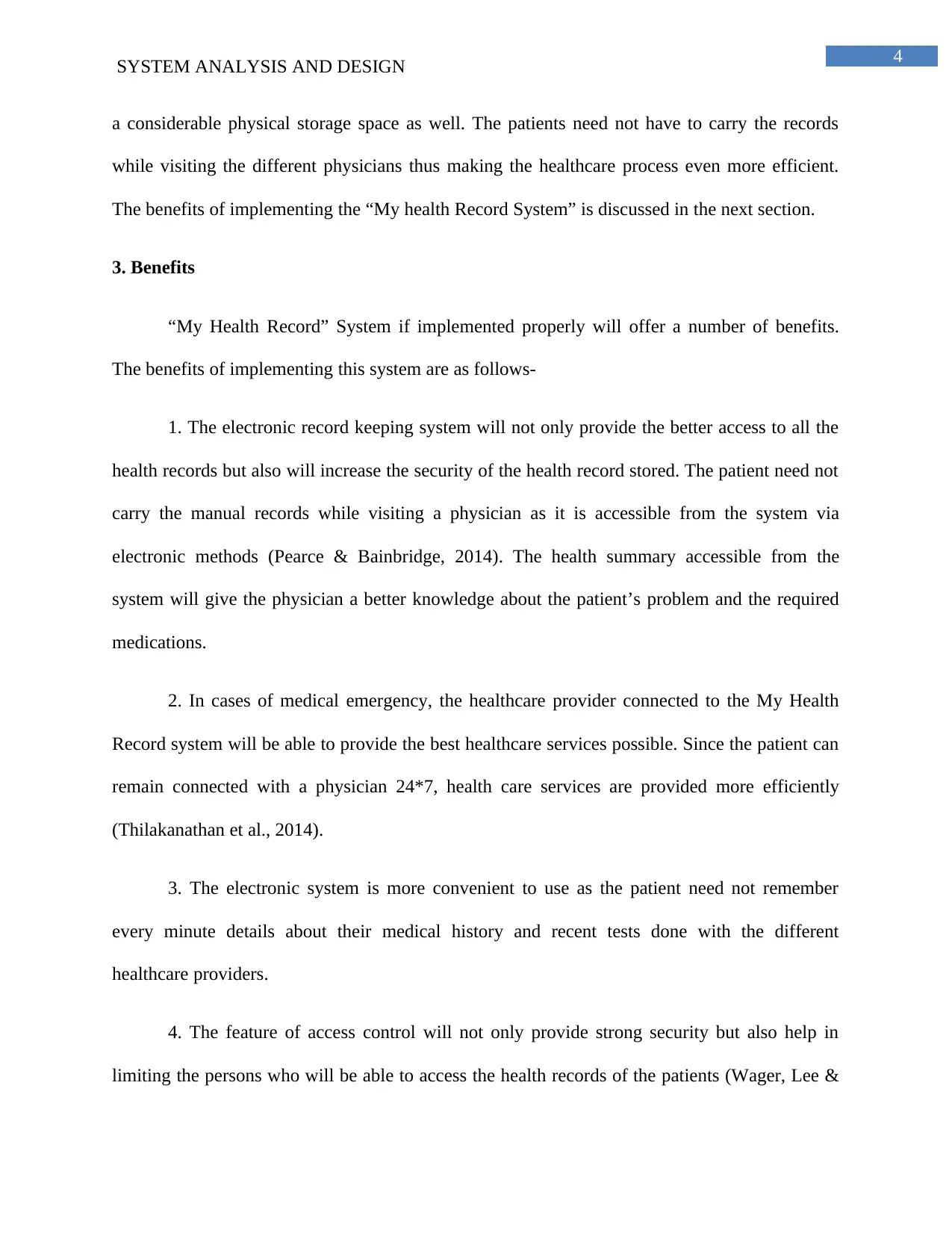
4
SYSTEM ANALYSIS AND DESIGN
a considerable physical storage space as well. The patients need not have to carry the records
while visiting the different physicians thus making the healthcare process even more efficient.
The benefits of implementing the “My health Record System” is discussed in the next section.
3. Benefits
“My Health Record” System if implemented properly will offer a number of benefits.
The benefits of implementing this system are as follows-
1. The electronic record keeping system will not only provide the better access to all the
health records but also will increase the security of the health record stored. The patient need not
carry the manual records while visiting a physician as it is accessible from the system via
electronic methods (Pearce & Bainbridge, 2014). The health summary accessible from the
system will give the physician a better knowledge about the patient’s problem and the required
medications.
2. In cases of medical emergency, the healthcare provider connected to the My Health
Record system will be able to provide the best healthcare services possible. Since the patient can
remain connected with a physician 24*7, health care services are provided more efficiently
(Thilakanathan et al., 2014).
3. The electronic system is more convenient to use as the patient need not remember
every minute details about their medical history and recent tests done with the different
healthcare providers.
4. The feature of access control will not only provide strong security but also help in
limiting the persons who will be able to access the health records of the patients (Wager, Lee &
SYSTEM ANALYSIS AND DESIGN
a considerable physical storage space as well. The patients need not have to carry the records
while visiting the different physicians thus making the healthcare process even more efficient.
The benefits of implementing the “My health Record System” is discussed in the next section.
3. Benefits
“My Health Record” System if implemented properly will offer a number of benefits.
The benefits of implementing this system are as follows-
1. The electronic record keeping system will not only provide the better access to all the
health records but also will increase the security of the health record stored. The patient need not
carry the manual records while visiting a physician as it is accessible from the system via
electronic methods (Pearce & Bainbridge, 2014). The health summary accessible from the
system will give the physician a better knowledge about the patient’s problem and the required
medications.
2. In cases of medical emergency, the healthcare provider connected to the My Health
Record system will be able to provide the best healthcare services possible. Since the patient can
remain connected with a physician 24*7, health care services are provided more efficiently
(Thilakanathan et al., 2014).
3. The electronic system is more convenient to use as the patient need not remember
every minute details about their medical history and recent tests done with the different
healthcare providers.
4. The feature of access control will not only provide strong security but also help in
limiting the persons who will be able to access the health records of the patients (Wager, Lee &
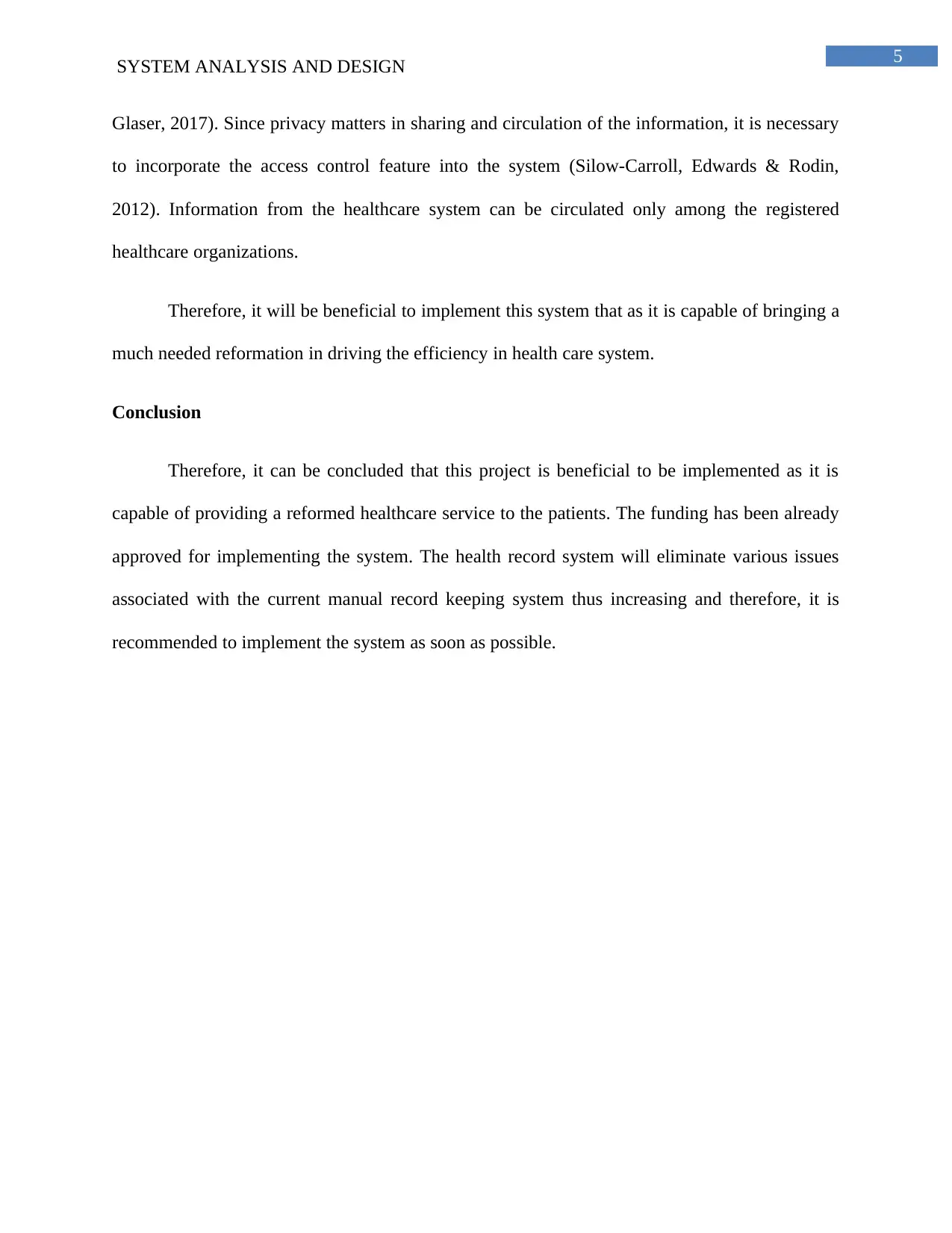
5
SYSTEM ANALYSIS AND DESIGN
Glaser, 2017). Since privacy matters in sharing and circulation of the information, it is necessary
to incorporate the access control feature into the system (Silow-Carroll, Edwards & Rodin,
2012). Information from the healthcare system can be circulated only among the registered
healthcare organizations.
Therefore, it will be beneficial to implement this system that as it is capable of bringing a
much needed reformation in driving the efficiency in health care system.
Conclusion
Therefore, it can be concluded that this project is beneficial to be implemented as it is
capable of providing a reformed healthcare service to the patients. The funding has been already
approved for implementing the system. The health record system will eliminate various issues
associated with the current manual record keeping system thus increasing and therefore, it is
recommended to implement the system as soon as possible.
SYSTEM ANALYSIS AND DESIGN
Glaser, 2017). Since privacy matters in sharing and circulation of the information, it is necessary
to incorporate the access control feature into the system (Silow-Carroll, Edwards & Rodin,
2012). Information from the healthcare system can be circulated only among the registered
healthcare organizations.
Therefore, it will be beneficial to implement this system that as it is capable of bringing a
much needed reformation in driving the efficiency in health care system.
Conclusion
Therefore, it can be concluded that this project is beneficial to be implemented as it is
capable of providing a reformed healthcare service to the patients. The funding has been already
approved for implementing the system. The health record system will eliminate various issues
associated with the current manual record keeping system thus increasing and therefore, it is
recommended to implement the system as soon as possible.
⊘ This is a preview!⊘
Do you want full access?
Subscribe today to unlock all pages.

Trusted by 1+ million students worldwide
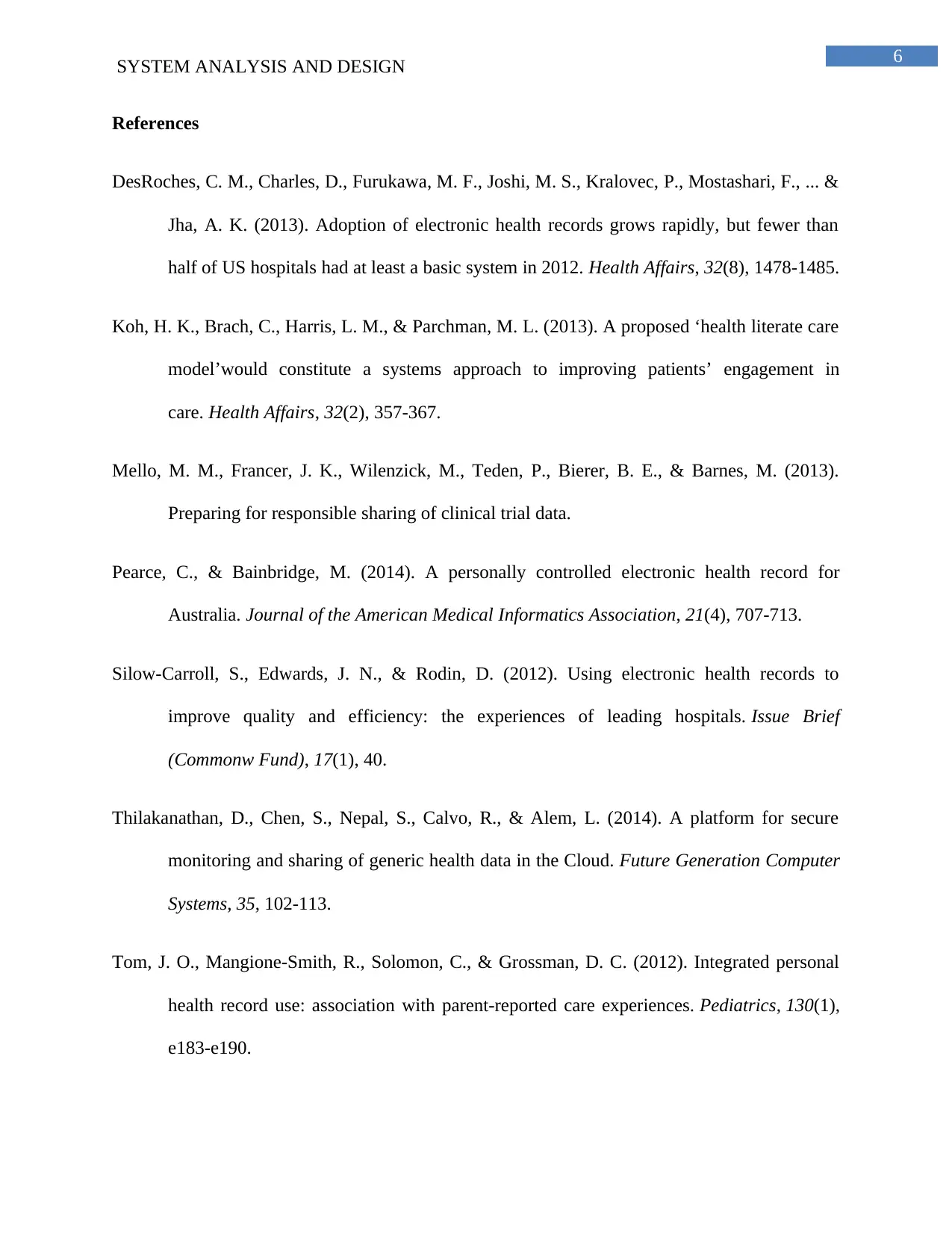
6
SYSTEM ANALYSIS AND DESIGN
References
DesRoches, C. M., Charles, D., Furukawa, M. F., Joshi, M. S., Kralovec, P., Mostashari, F., ... &
Jha, A. K. (2013). Adoption of electronic health records grows rapidly, but fewer than
half of US hospitals had at least a basic system in 2012. Health Affairs, 32(8), 1478-1485.
Koh, H. K., Brach, C., Harris, L. M., & Parchman, M. L. (2013). A proposed ‘health literate care
model’would constitute a systems approach to improving patients’ engagement in
care. Health Affairs, 32(2), 357-367.
Mello, M. M., Francer, J. K., Wilenzick, M., Teden, P., Bierer, B. E., & Barnes, M. (2013).
Preparing for responsible sharing of clinical trial data.
Pearce, C., & Bainbridge, M. (2014). A personally controlled electronic health record for
Australia. Journal of the American Medical Informatics Association, 21(4), 707-713.
Silow-Carroll, S., Edwards, J. N., & Rodin, D. (2012). Using electronic health records to
improve quality and efficiency: the experiences of leading hospitals. Issue Brief
(Commonw Fund), 17(1), 40.
Thilakanathan, D., Chen, S., Nepal, S., Calvo, R., & Alem, L. (2014). A platform for secure
monitoring and sharing of generic health data in the Cloud. Future Generation Computer
Systems, 35, 102-113.
Tom, J. O., Mangione-Smith, R., Solomon, C., & Grossman, D. C. (2012). Integrated personal
health record use: association with parent-reported care experiences. Pediatrics, 130(1),
e183-e190.
SYSTEM ANALYSIS AND DESIGN
References
DesRoches, C. M., Charles, D., Furukawa, M. F., Joshi, M. S., Kralovec, P., Mostashari, F., ... &
Jha, A. K. (2013). Adoption of electronic health records grows rapidly, but fewer than
half of US hospitals had at least a basic system in 2012. Health Affairs, 32(8), 1478-1485.
Koh, H. K., Brach, C., Harris, L. M., & Parchman, M. L. (2013). A proposed ‘health literate care
model’would constitute a systems approach to improving patients’ engagement in
care. Health Affairs, 32(2), 357-367.
Mello, M. M., Francer, J. K., Wilenzick, M., Teden, P., Bierer, B. E., & Barnes, M. (2013).
Preparing for responsible sharing of clinical trial data.
Pearce, C., & Bainbridge, M. (2014). A personally controlled electronic health record for
Australia. Journal of the American Medical Informatics Association, 21(4), 707-713.
Silow-Carroll, S., Edwards, J. N., & Rodin, D. (2012). Using electronic health records to
improve quality and efficiency: the experiences of leading hospitals. Issue Brief
(Commonw Fund), 17(1), 40.
Thilakanathan, D., Chen, S., Nepal, S., Calvo, R., & Alem, L. (2014). A platform for secure
monitoring and sharing of generic health data in the Cloud. Future Generation Computer
Systems, 35, 102-113.
Tom, J. O., Mangione-Smith, R., Solomon, C., & Grossman, D. C. (2012). Integrated personal
health record use: association with parent-reported care experiences. Pediatrics, 130(1),
e183-e190.
Paraphrase This Document
Need a fresh take? Get an instant paraphrase of this document with our AI Paraphraser
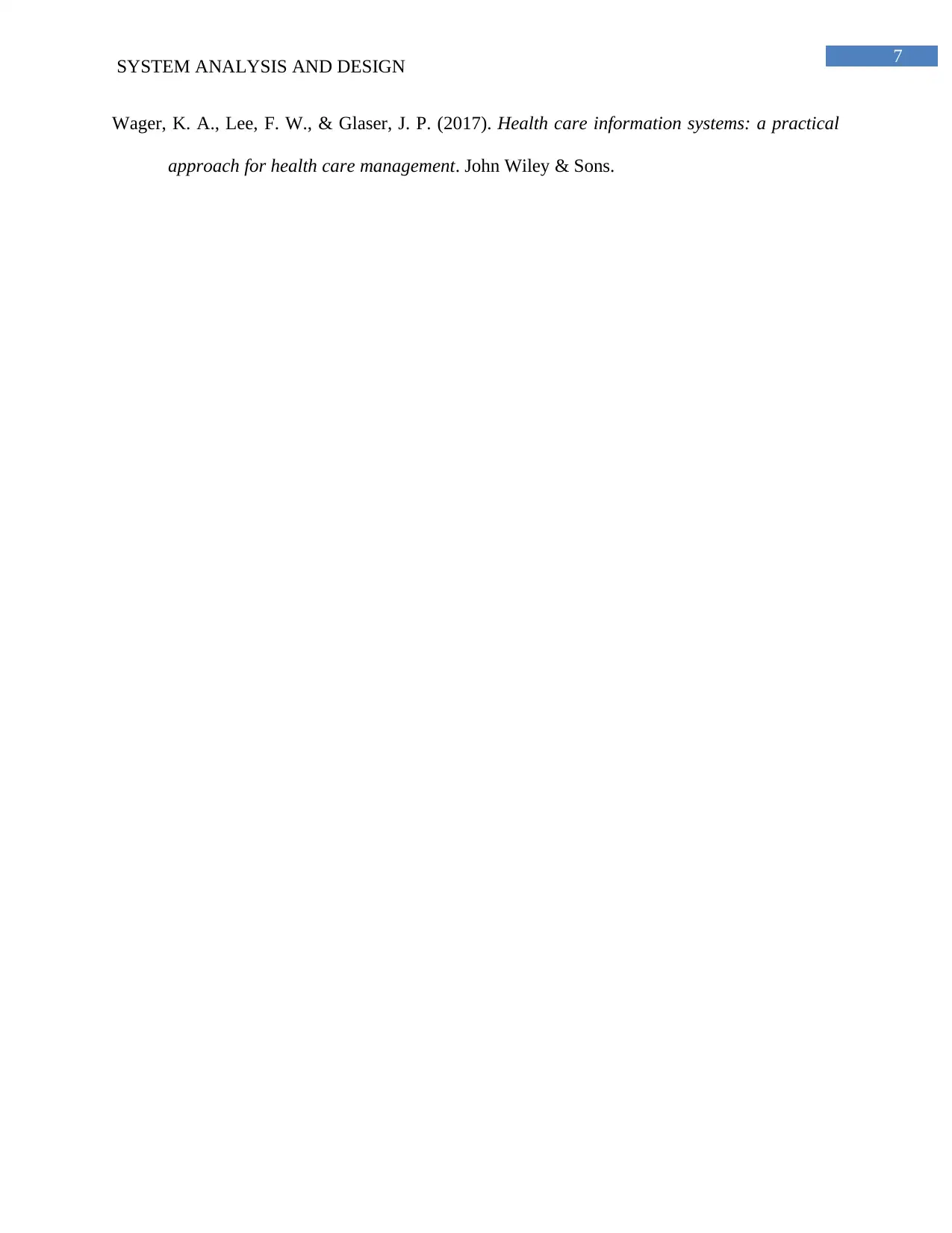
7
SYSTEM ANALYSIS AND DESIGN
Wager, K. A., Lee, F. W., & Glaser, J. P. (2017). Health care information systems: a practical
approach for health care management. John Wiley & Sons.
SYSTEM ANALYSIS AND DESIGN
Wager, K. A., Lee, F. W., & Glaser, J. P. (2017). Health care information systems: a practical
approach for health care management. John Wiley & Sons.
1 out of 8
Related Documents
Your All-in-One AI-Powered Toolkit for Academic Success.
+13062052269
info@desklib.com
Available 24*7 on WhatsApp / Email
![[object Object]](/_next/static/media/star-bottom.7253800d.svg)
Unlock your academic potential
Copyright © 2020–2025 A2Z Services. All Rights Reserved. Developed and managed by ZUCOL.





